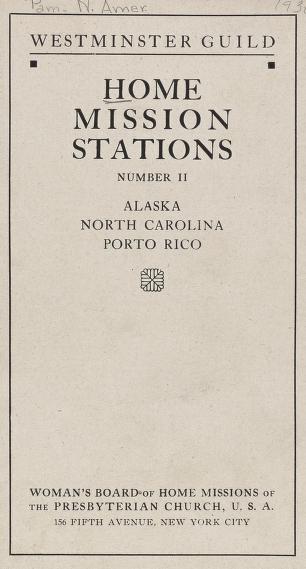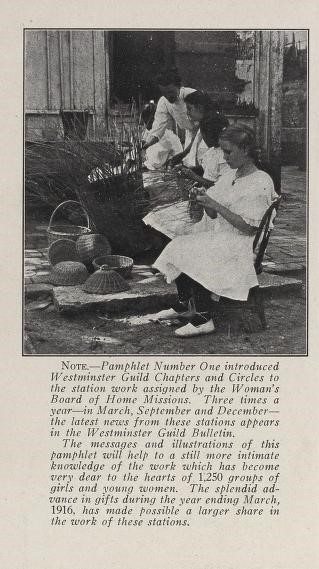

Like the previous primary source, this pamphlet gives an overview of three missions in Alaska, North Carolina, and Puerto Rico. Again, this document was published by the Presbyterian Church Woman’s Board of Home Missions and was the second pamphlet published in 1916. Similarly to the last publication, this edition updates its readers on what is happening in the three listed locations. The Puerto Rico section, which again centers on the “Marina Mission” in Mayaguez, focuses on the “improvements” made in the community since the foundation of the Marina mission in 1907 (Presbyterian Church in the U.S.A. Woman’s Board of Home Missions, 3-4). More than the last entry, this edition of “Home Mission Stations” reveals how Puerto Rican converts are viewed by American missionaries. The authors praise the girls who have converted and work with the school who have learned a number of “womanly skills” like lacemaking, sewing, and basket weaving (Presbyterian Church in the U.S.A. Woman’s Board of Home Missions, 3). Additionally, the entry praises the “native” girls on their ability to read and write in English and their advancement to professions deemed worthy by the mission, such as teachers, nurses, and missionary workers (Presbyterian Church in the U.S.A. Woman’s Board of Home Missions, 4). Clearly, these authors are in support of this missionary work because they see the need for such work in the community. They see Puerto Rico as an immoral place where the people need to be guided by American Protestantism.
Interestingly, this pamphlet gives us a bit of insight not only into the American missionaries but also into the “native helpers” of the Americans. This discussion of the missionaries and their attempts to educate indigenous women to become missionary workers illustrates that the Church recognized the importance of allowing native agency within missionary work in order to best spread Protestantism to the island. In short, within American missionary work in Puerto Rico, there is an intense interplay of perspectives that cannot be boiled down to a simple reason for the attempted conversion of the island.
“The March, 1916, number of the Bulletin gives a brief review of the growth at the Marina Mission. Little by little the work has developed until the “impossible” slum district of July, 1907, has become attractive in appearance and a safe place in which to live. The little chapel schoolhouse by the sea was the nucleus around which has grown a group of useful buildings for industrial classes, kindergarten, day nursery, teacher’s home, etc.
Several girls, trained in the mission schools of the Woman’s Board, are the teachers and assistants for lace making, drawn work, basketry, etc. The drawn work is so beautiful that several bridal undergarments and an exquisite wedding gown were recently made at the Marina Mission for brides-to-be in the States. The material for these garments was purchased here, but the designing and needlework were done by Miss Hazen and her assistants. Numerous other gowns with exquisite drawn work, in white and colors, are also made at the mission and sold to tourists.
The latest, and very important acquisition to the working force is the district nurse — a graduate of our Presbyterian Hospital training class at San Juan. Another of the girls from this mission is in the States this year in order to fit herself for more efficient service among her own people. These native girls are teachers in Sunday school, leaders in the Christian Endeavor Society, house-to-house visitors, and “all around” wholesome Christians.
We report a Westminster Guild Chapter and Circle in Mayaguez, and a Chapter at Aguadilla, Porto Rico. Of the one at the Marina we hear: ‘The leaders take up the subject for discussion in a very capable way. All the studying and reciting is in English, and no girl refers to her book when taking part in the meeting. They are doing some real missionary work through our visiting nurse, but their study is awakening them to a keen interest in mission work in foreign lands.’
With the registration from Aguadilla came this message: ‘It gives me great joy to tell you that we have a Westminster Guild in Aguadilla. I organized it several weeks ago and have waited before writing to see how the girls were going to take hold of the study. So far they have shown great interest and have good meetings. They meet on Sundays twice a month here in our house and have a membership of eighteen. There were fourteen at the meeting last Sunday. We pay five cents a month, which is to be used for local charity (our day nursery, I hope).
‘The girls are making great plans for the next meeting on Porto Rico. They are so interested and all want to lead. All are asked to take part. Last Sunday I asked how many were products of Presbyterian work, and everyone is, either from the school here, the Colegio that was in Mayaguez, or the hospital of San Juan. Isn’t that a fine record for the Presbyterian work, in the past ?’” (Pages 3-4)
Sources
Presbyterian Church in the USA Woman’s Board of Home Missions. “Home mission stations” Columbia University Libraries. https://archive.org/details/ldpd_11375189_000/page/n1/mode/2up